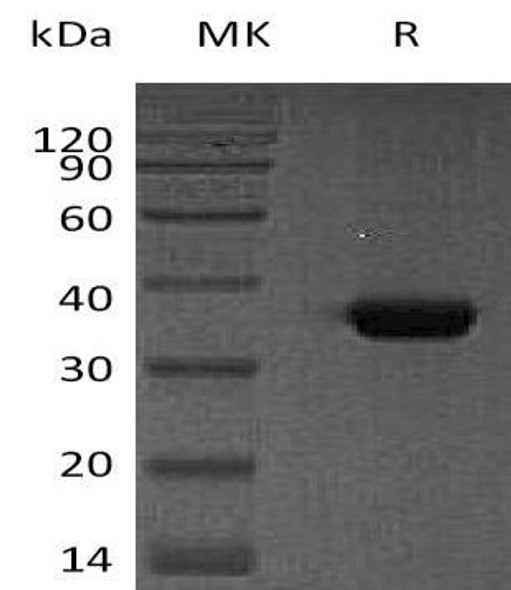Description
| Product Name: | Human SPARC Recombinant Protein |
| Product Code: | RPPB4799 |
| Size: | 50µg |
| Species: | Human |
| Target: | SPARC |
| Synonyms: | Osteonectin, ON, Basement-membrane protein 40, BM-40, SPARC, Secreted Protein acidic and Rich in Cysteine. |
| Source: | Escherichia Coli |
| Physical Appearance: | Sterile Filtered White lyophilized (freeze-dried) powder. |
| Formulation: | The SPARC (1 mg/ml) was lyophilized after extensive dialyses against 20mM PBS pH-7.4. |
| Solubility: | It is recommended to reconstitute the lyophilized SPARC in sterile 18M?-cm H2O not less than 100 �g/ml, which can then be further diluted to other aqueous solutions. |
| Stability: | Lyophilized Osteonectin although stable at room temperature for 3 weeks, should be stored desiccated below -18°C. Upon reconstitution BM-40 should be stored at 4°C between 2-7 days and for future use below -18°C.For long term storage it is recommended to add a carrier protein (0.1% HSA or BSA).Please prevent freeze-thaw cycles. |
| Purity: | Greater than 95.0% as determined by:(a) Analysis by RP-HPLC.(b) Analysis by SDS-PAGE. |
| Amino Acid Sequence: | MSYYHHHHHHPQQEALPDETEVVEETVAEVTEVSVGANPVQVEVGEFDDGAEETEEEVVAENPCQNHHCKHGKVCELDENNTPMCVCQDPTSCPAPIGEFEKVCSNDNKTFDSSCHFFATKCTLEGTKKGHKLHLDYIGPCKYIPPCLDSELTEFPLRMRDWLKNVLVTLYERDEDNNLLTKQKLRVKKIHENEKRLEAGDHPVELLARDFEKNYNMYIFPVHWQFGQLDQHPIDGYLSHTELAPLRAPLIPMEHCTTRFFETCDLDNDKYIALDEWAGCFGIKQKDIDKDLVI |
SPARC, an acronym for �secreted protein, acidic and rich in cysteine�, is also known as osteonectin or BM-40. It is the founding member of a family of secreted matricellular proteins with similar domain structure. The 303 amino acid, 43 kDa protein contains a 17 aa signal sequence, an N-terminal acidic region that binds calcium, a follistatin domain containing Kazal-like sequences, and a C-terminal extracellular calcium (EC) binding domain with two EF-hand motifs. SPARC is produced by fibroblasts, capillary endothelial cells, platelets and macrophages, especially in areas of tissue morphogenesis and remodeling. SPARC shows context-specific effects, but generally inhibits adhesion, spreading and proliferation, and promotes collagen matrix formation. For endothelial cells, SPARC disrupts focal adhesions and binds and sequesters PDGF and VEGF. SPARC is abundantly expressed in bone, where it promotes osteoblast differentiation and inhibits adipogenesis.
Osteonectin Human Recombinant fused with 6X His tag produced in E.Coli is a single, non-glycosylated, polypeptide chain containing 295 amino acids and having a molecular mass of 34 kDa.SPARC is expressed with a 6 amino acid His tag at N-Terminus and purified by proprietary chromatographic techniques.
| UniProt Protein Function: | SPARC: Appears to regulate cell growth through interactions with the extracellular matrix and cytokines. Binds calcium and copper, several types of collagen, albumin, thrombospondin, PDGF and cell membranes. There are two calcium binding sites; an acidic domain that binds 5 to 8 Ca(2+) with a low affinity and an EF-hand loop that binds a Ca(2+) ion with a high affinity. Belongs to the SPARC family. |
| UniProt Protein Details: | Protein type:Secreted; Secreted, signal peptide Chromosomal Location of Human Ortholog: 5q31.3-q32 Cellular Component: extracellular space; platelet alpha granule membrane; nuclear matrix; cell surface; mitochondrion; cytoplasm; plasma membrane; extracellular region; basement membrane Molecular Function:collagen binding; protein binding; extracellular matrix binding; calcium ion binding Biological Process: response to peptide hormone stimulus; receptor-mediated endocytosis; response to gravity; platelet activation; extracellular matrix organization and biogenesis; ossification; response to cAMP; heart development; response to glucocorticoid stimulus; response to lipopolysaccharide; signal transduction; response to L-ascorbic acid; negative regulation of angiogenesis; platelet degranulation; response to cadmium ion; response to ethanol; response to cytokine stimulus; response to lead ion; negative regulation of endothelial cell proliferation; regulation of cell morphogenesis; response to calcium ion; blood coagulation; inner ear development; lung development Disease: Osteogenesis Imperfecta, Type Xvii |
| NCBI Summary: | This gene encodes a cysteine-rich acidic matrix-associated protein. The encoded protein is required for the collagen in bone to become calcified but is also involved in extracellular matrix synthesis and promotion of changes to cell shape. The gene product has been associated with tumor suppression but has also been correlated with metastasis based on changes to cell shape which can promote tumor cell invasion. Three transcript variants encoding different isoforms have been found for this gene. [provided by RefSeq, Jun 2015] |
| UniProt Code: | P09486 |
| NCBI GenInfo Identifier: | 4507171 |
| NCBI Gene ID: | 6678 |
| NCBI Accession: | NP_003109 |
| UniProt Related Accession: | P09486 |
| Molecular Weight: | 35kDa |
| NCBI Full Name: | SPARC isoform 1 |
| NCBI Synonym Full Names: | secreted protein acidic and cysteine rich |
| NCBI Official Symbol: | SPARC�� |
| NCBI Official Synonym Symbols: | ON; OI17; BM-40�� |
| NCBI Protein Information: | SPARC |
| UniProt Protein Name: | SPARC |
| UniProt Synonym Protein Names: | Basement-membrane protein 40; BM-40; Osteonectin; ON; Secreted protein acidic and rich in cysteine |
| UniProt Gene Name: | SPARC�� |
| UniProt Entry Name: | SPRC_HUMAN |






